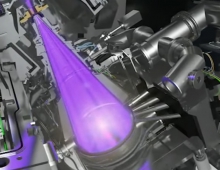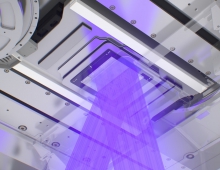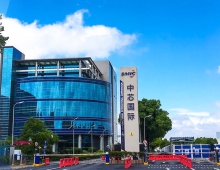
SPIE: ASML Demos NXE 3400B Production of 140 Wafers per Hour
ASML is making progress in the performance of its latest extreme ultraviolet (EUV) lithography system and demonstrated its NXE 3400B system delivering 140 wafers/hour.
The NXE 3400B uses ASML's fifth-generation scanner characterized by an NA of 0.33, a Pupil Fill Ratio (PFR) of 0.2, and was running at the company's headquarters in the Netherlands and in a lab environment. According to ASML's paper presented at SPIE, the system showed a throughput capability of 125 wafers per hour.

The lab demo was conducted without use of a protective pellicle on the wafers. The tests exposed a full field with 96 fields using a dose of 20 mJ/cm2. A test using an 83-percent transmissive pellicle reached 100 wph. ASML targets a 90-percent transmissive pellicle with 125 wph throughput that can withstand a 300W light source.
ASML said that advances in source power and system availability have enabled a continued increase of productivity. To maximize the number of yielding dies per day excellent Overlay, Focus, and Critical Dimension (CD) control have been realized, combining intrinsic tool stability with holistic control schemes. ASML also showed matching performance for both Overlay and Imaging, and further improvements in Focus Process Dependencies for the 5nm node.
In order to reduce defects from contaminating particles, ASML is working in parallel on the pellicle and a cleaner scanner that doesn't need a pellicle. The company aims to eliminate almost all particles per 10,000 wafers next year.
ASML aims to tune the light source to 250W for throughput of 150 wafers per hour and ship it to customers before June for use on 7nm process nodes.
The NXE 3400B system will be used for volume production by the end of 2018 and next year. ASML targets greater than 90 percent uptime.
Late this year, ASML aims to deliver an improvement package that enables overlays down to 1.7nm, slightly below the required 1.9nm target for 5nm. In mid-2019 it plans a productivity enhancement package that boosts throughput to 145 wph.
Moving on, ASML plans to release a model 3400C in 2020. This one will deliver additional improvements, boosting throughput to 155 w/h.
ASML's roadmap also includes a more advanced system for the 2023-24 timeframe. This one will use larger optics, a higher power light source and faster internal pathways to achieve a maximum of 185 w/h while printing features with dimensions as small as 8nm.
Optics maker Carl Zeiss SMT is now installing the first metrology system needed to make the system's significantly high NA lenses. The company is collaborating with ASML, with the Dutch company inject a $1.9 billion investment.




















